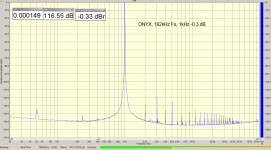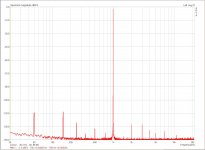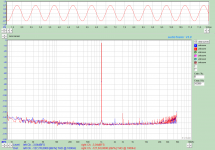So, the real harmonics are -110dB below the fundamental @1kHz -20dBFs?
The harmonics are around -130 dB from the fundamental. But you need to be about -18 dBFS to get that performance. At -3 dBFS expect not much better than-110 harmonics typically with the AK5394A. Unique to the AK5394A is the flat noise floor. All the other audio delta sigma ADC's have the noise floor rising starting around 40 KHz. Probably irrelevant for audio but significant for measuring.
The harmonics are around -130 dB from the fundamental. But you need to be about -18 dBFS to get that performance.
You mean: F1=-18 dB and F2 (or F3) =-148dB ?
At -3 dBFS expect not much better than-110 harmonics typically with the AK5394A.
Mmmmm, you remember my measurements?
Attachments
Last edited:
At -3 dBFS expect not much better than-110 harmonics typically with the AK5394A.
Hmm.. was strange also for me, I have just measured this, (the output of Sonny's Mirand Dac)
Attachments
You mean: F1=-18 dB and F2 (or F3) =-148dB ?
Mmmmm, you remember my measurements?
THD is a relative measure to the fundamental. So the fundamental doesn't have to be at any particular level and there is no need to add anything to it.
THD+N is also a relative measure but it does make a different in results using a lower level signal because the noise doesn't change.
I am sure Demian meant -18dBFS out to the DAC. In my test, shown in post #714, I used -20dBFS out to the DAC, but that does not make a big difference, compared to -18dBFS.
The -3dBFS is the input level seen by the ADC. At this sort of level the ADC will distort more than at e.g. -10dBFS. And there is some temperature dependence at the high levels.
The -3dBFS is the input level seen by the ADC. At this sort of level the ADC will distort more than at e.g. -10dBFS. And there is some temperature dependence at the high levels.
my recent experience has been with the EMU which has some compromises in its desing. Jens would have a much better idea of the capabilities of his unit.
One real challenge in comparing ADC based analyzers and traditional analyzers in that the traditional analyzers have a sophisticated AGC in effect, making the input level optimum for the analyzer. The ADC equivalent would be a fine grained attenuator/amp that would keep the ADC input near its optimum. The only soundcard system that does this I know of is Praxis which has a digital pot in its interface and uses the software to optimize the level. Fallout from needing to work with primitive early soundcards where it was needed.
One real challenge in comparing ADC based analyzers and traditional analyzers in that the traditional analyzers have a sophisticated AGC in effect, making the input level optimum for the analyzer. The ADC equivalent would be a fine grained attenuator/amp that would keep the ADC input near its optimum. The only soundcard system that does this I know of is Praxis which has a digital pot in its interface and uses the software to optimize the level. Fallout from needing to work with primitive early soundcards where it was needed.
Hi Jens,
I'm still interested (since a year ago).
One question, will you provide MS signed drivers?
Hi Anders,
Sorry for the late answer.
Yes, we will provide an MS signed driver.
I do confirm my interest ( pm sent )
Other that have the definitive spec would be interesting to know if in the future will be possible buy an analyzer's hardware upgrade ( for example for implement a new DAC or ADC chip with better specs ) at a reasonable-discounted price or will be necessary buy again a new unit every time.
Thanks and regards
Marco
Other that have the definitive spec would be interesting to know if in the future will be possible buy an analyzer's hardware upgrade ( for example for implement a new DAC or ADC chip with better specs ) at a reasonable-discounted price or will be necessary buy again a new unit every time.
Thanks and regards
Marco
...the Audio Analyzer will be available to members of this forum at a discounted price for a limited period of time.
The diyaudio group buy price is USD 1199 with more than 10 units.
The diyaudio group buy price is USD 999 with more than 50 units.
...
The offer is limited to a maximum of 2 units per diyaudio member.
The offer is open until the end of January 2017.
...
The formal part of this may not be available until early January.
Hi Jens
Any news regarding these points? Please count me in for one (or maybe two) units. Just make sure we can get our formal orders to you before the end of January, when you offer ends ;-)
Hi Jens
Any news regarding these points? Please count me in for one (or maybe two) units. Just make sure we can get our formal orders to you before the end of January, when you offer ends ;-)
Don't worry.
The formalities may still take a while to sort out. But the order period will of course be extended if it takes too long.
I think at some point Jens will need to post a list where we can all sign up; I can't imagine dozens of PMs from guys like us who all want to purchase a unit is going to be manageable at his end.
I think at some point Jens will need to post a list where we can all sign up; I can't imagine dozens of PMs from guys like us who all want to purchase a unit is going to be manageable at his end.
+1
I think at some point Jens will need to post a list where we can all sign up; I can't imagine dozens of PMs from guys like us who all want to purchase a unit is going to be manageable at his end.
Right!
With a 1V balanced output from the generator (-20dBFS) looped back to the analyzer, I have measured a THD of just below -130dB average over the 18 units that have been built so far.
The worst measurement in this test was -127.8dB. The best one was -133.7dB.
This was measured at a sample rate of 48 kHz.
If only one input channel is used the distortion seems to drop by 1 or 2 dB.
Looking very good! Could you also post the result of using unbalanced output? Most consumer audio gear is unbalanced, so that is a mode that is going to be used quite often. It would be reassuring to see that the unbalanced performance is not much worse than the balanced performance.
Also, from the first post: "16. Expansion connector for future digital I/O" is that still true? Do you have any plans here? Is there room on the front or back panel for SPDIF i/o for example?
- OJG
Last edited:
Single ended
Good point! Even some professional gear misbehaves in single ended mode.
See: this and this
Cheers, E.
Looking very good! Could you also post the result of using unbalanced output? Most consumer audio gear is unbalanced, so that is a mode that is going to be used quite often. It would be reassuring to see that the unbalanced performance is not much worse than the balanced performance.
[...]
- OJG
Good point! Even some professional gear misbehaves in single ended mode.

See: this and this
Cheers, E.
- Home
- Design & Build
- Equipment & Tools
- DIY Audio Analyzer with AK5397/AK5394A and AK4490



